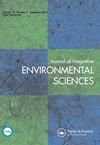Constructing a new tool for assessing environmental worldviews of individuals and organizations – case environmental worldview analysis of seven political parties in Finland
IF 3.5
4区 环境科学与生态学
Q3 ENVIRONMENTAL SCIENCES
Journal of Integrative Environmental Sciences
Pub Date : 2016-09-19
DOI:10.1080/1943815X.2016.1225772
引用次数: 2
Abstract
Abstract Environmental disputes often encompass both a conflict over the practical issue itself and, more fundamentally, a conflict over environmental worldviews (EWVs). In this study, a new two-dimensional tool has been created for measuring prevailing EWVs in individuals and organizations. Respondent’s place on the horizontal axis shows preference on an institutional scale where environmental issues should be handled. Therefore, the x-axis shows the relationship between social greens (highlighting local communities) and institutionalists (believing in strong global cooperation and institutions). The vertical axis describes focus on sustainability/nature vs. market/economy, thus showing preference between bioenvironmentalists and market liberals. EWVs were measured in Finnish political parties, actors in environmental administration, many non-environmental organizations and public innovation funders. Principal component analysis showed that the two-dimensional analysis fits well to the EWV analysis. Data (n = 1637) approximates symmetrically the bell curve of a normal distribution in both the axes, with neglible linear relation between the axes. A case study of seven Finnish political parties revealed remarkable EWV differences, logically compared to the existing research. Moreover, the respondent’s views on globalization were found to follow a very different logic from the environmental concern. An analytical tool of EWVs fosters harmonious decision-making, facilitating constructive solutions in environmental debate.建构评估个人与组织环境世界观的新工具——芬兰七个政党环境世界观个案分析
环境争议通常既包括对实际问题本身的冲突,更根本的是对环境世界观的冲突。在这项研究中,创建了一个新的二维工具来衡量个人和组织中普遍存在的ewv。被访者在横轴上的位置显示了在制度尺度上应该处理环境问题的偏好。因此,x轴显示了社会绿色主义者(强调当地社区)和制度主义者(相信强有力的全球合作和制度)之间的关系。纵轴描述了对可持续性/自然与市场/经济的关注,从而显示了生物环保主义者和市场自由主义者之间的偏好。在芬兰的政党、环境管理机构、许多非环境组织和公共创新资助者中测量了ewv。主成分分析表明,二维分析与EWV分析吻合较好。数据(n = 1637)在两个轴上对称地近似于正态分布的钟形曲线,轴线之间的线性关系可以忽略不计。与现有的研究相比,对七个芬兰政党的案例研究揭示了显著的EWV差异。此外,受访者对全球化的看法与对环境问题的看法有着非常不同的逻辑。ewv的分析工具促进了和谐的决策,促进了环境辩论中的建设性解决方案。
本文章由计算机程序翻译,如有差异,请以英文原文为准。
求助全文
约1分钟内获得全文
求助全文
来源期刊

Journal of Integrative Environmental Sciences
ENVIRONMENTAL SCIENCES-
CiteScore
3.90
自引率
0.00%
发文量
13
审稿时长
>12 weeks
期刊介绍:
Journal of Integrative Environmental Sciences (JIES) provides a stimulating, informative and critical forum for intellectual debate on significant environmental issues. It brings together perspectives from a wide range of disciplines and methodologies in both the social and natural sciences in an effort to develop integrative knowledge about the processes responsible for environmental change. The Journal is especially concerned with the relationships between science, society and policy and one of its key aims is to advance understanding of the theory and practice of sustainable development.
 求助内容:
求助内容: 应助结果提醒方式:
应助结果提醒方式:


